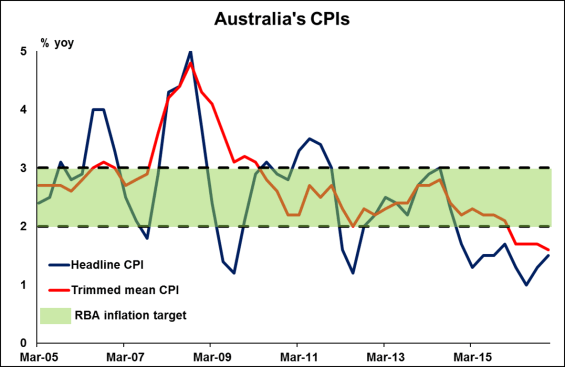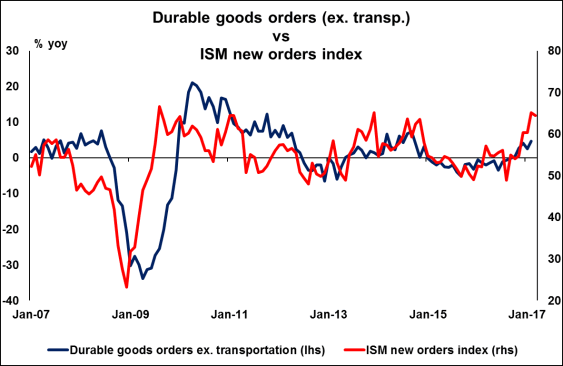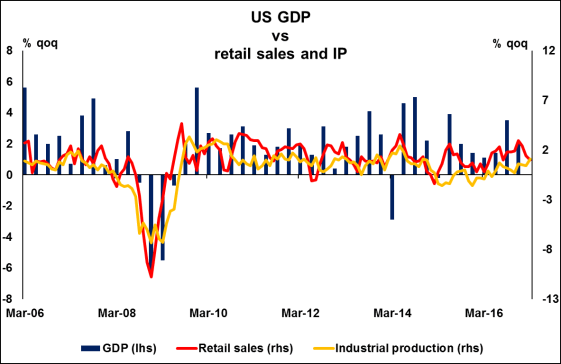Next week’s market movers
- In France, we have the 1st round of the French presidential election. Given that among the leading candidates there are two Eurosceptic, the outcome would have a significant impact in the markets.
- We expect the ECB to offer no changes and maintain a balanced tone, given officials’ yield concerns and that the meeting takes place before the second round of the French election.
- We believe that the BoJ will leave policy unchanged, but may revise down its inflation forecasts.
- We also get key economic data from the US, the UK, Eurozone, Japan, and Australia.
On Sunday, we have the 1st round of the French presidential election, but the final outcome is unlikely to be sealed on that day. According to the opinion polls, there is no candidate gaining the absolute majority, so a second round between the two leading candidates is very likely to be held on the 7th of May.
A couple of weeks ago, the leading candidates were three: Emmanuel Macron, Marine Le Pen, and Francois Fillon. Nevertheless, following a strong performance in the TV debates, left-wing candidate Jean-Luc Melenchon enjoyed a stellar rise of support. His program displays a similar Eurosceptic stance to Le Pen’s. He advocates for holding a "Frexit" referendum as well. Therefore, a run-off between him and Le Pen seems to be the biggest risk scenario for the financial world.
If something like that takes flesh and bones, we expect the euro to sink as investors will likely price in a much greater risk of European disintegration. A general risk-aversion mood is likely to dominate as well. Safe-havens like the yen are likely to benefit, while equity markets, especially European indices, could take the down road. The other side of the coin is a Macron – Fillon second round. In this case, the opposite market reaction may be observed, as this run-off combination may eliminate the risk for any "Frexit" referendum.
However, at the moment, polls suggest that the most likely outcome is for Macron and Le Pen to make it to the second round, with the former winning by a large margin. In general, Macron is seen as the winner against any other of the candidates. So if Macron makes it on Sunday, this could cause a market relief and the common currency may open Monday with a gap up. In the less likely scenario of him being kicked out, the only combination that could be seen as relatively pro risk is a Fillon – Le Pen run off, given that polls give the final victory to Fillon. In a Fillon – Melenchon race, Melenchon is preferred.
Of course, much will depend on who gets the first place in the aforementioned combinations, and by how much margin.
On Monday, we get Germany’s Ifo survey for April. With no forecast available, we see the likelihood for both the current conditions and expectations indices to have risen further. We base our view on the ZEW survey for the month, which showed increased optimism in the German economy. What’s more, PMI surveys showed that economic growth remained strong at the start of the second quarter, despite slightly weaker increases in both manufacturing output and services activity.

On Tuesday, the economic calendar is light, with no major events or indicators due to be released.
On Wednesday, Australia’s CPI data for Q1 are coming out. Expectations are for both the headline and trimmed mean rates to have risen, with the headline print returning back within the RBA’s inflation target range of 2-3%. When they last met, RBA policymakers highlighted the softness in labor market indicators, and that the recently announced supervisory measures with regards to lending could ease financial stability risks. As we already noted, this suggests to us that once these measures take effect, the Bank would be more flexible to cut rates again if needed without being concerned that its actions would amplify risks to the economy. Following the remarkable jobs report for March, released after that meeting, we don’t think that the Bank will act at its upcoming gathering on the 2nd of May. A potential acceleration in both the headline and trimmed mean CPIs could decrease further the possibility for any action.

On Thursday, during the Asian morning, BoJ will announce its policy decision. At its latest gathering, the Bank left its expansionary monetary policy program unchanged and maintained a slightly optimistic assessment with regards to the Japanese economy. Since that meeting the nation’s core CPI rate ticked up to +0.2% yoy from +0.1% yoy, but the forward-looking Tokyo core CPI rate slid deeper into the negative territory. The data suggest that the Bank may lower somewhat its inflation forecasts when it publishes its quarterly outlook report at its policy meeting next week. However, we don’t believe that this will lead to additional stimulus. We don’t expect a small revision in projected CPI to alter the BoJ’s policy stance. We believe that the focus of the meeting will be once again on the Bank’s assessment regarding the Japanese economy.
During the European day, the highlight will be the ECB policy decision, followed by a press conference from President Draghi. At its latest policy meeting, the Bank kept is monetary policy unchanged and in the statement accompanying the decision, it maintained its dovish forward guidance. However, Draghi’s press conference had a more hawkish tilt, giving investors the idea that the days of aggressive ECB easing may be behind us. Draghi’s remarks were followed by similar speeches from several ECB officials, adding more fuel to expectations that the era of ultra-loose monetary policy is approaching its final stages.
Nevertheless, on the 29th of March, a Reuters report came to appease all this euphoria and to drag investors back down to earth. The report noted that market participants over-interpreted the signals from the ECB’s March policy meeting and revealed that ECB officials only wanted to communicate reduced risks and not a step towards a reduction in stimulus. In addition, it was noted that policymakers are now cautious of making any new changes to the April statement, and that they are worried of a potential surge in the bloc’s government bond yields.
his suggests that we are unlikely to get any changes from this meeting, especially having in mind that it takes place before the second round of the French election, a political event that could add a risk premium to European bond yields, and consequently enhance the concerns of ECB policymakers with regards to a surge in yields. Therefore, we expect the ECB to maintain a balanced tone, at least until the outcome of the election is sealed.
On the indicators’ front, we get Germany’s preliminary CPI for April one day ahead of Eurozone’s print. The forecast is for the nation’s CPI to have accelerated to +1.9% yoy from +1.6% yoy in March, something that could raise speculation that the bloc’s rate may also accelerate and meet its forecast of +1.8% yoy.
From the US, we get durable goods orders for March, but no forecast is available yet. Our own view is that the core figure may slow somewhat after rising 0.5% mom in February. We base our expectations on the nation’s ISM manufacturing PMI for the month, where the New Orders sub-index slid somewhat.

On Friday, during the Asian morning, we get CPI data for March from Japan. In the absence of any forecast, we see the case for both the headline and core rates to have ticked down. We base our view on the nation’s forward-looking Tokyo CPIs for the month, where both the headline and core rates slid further into the negative territory. Something like that combined with a potential downside revision in the Bank’s inflation forecasts at Thursday’s meeting, could eliminate any speculation left with regards to stimulus reduction, at least for coming months. We continue to expect the Bank to keep its ultra-loose QQE with yield-curve control framework unchanged in the foreseeable future.
During the European day, we get Eurozone’s preliminary CPI data for April. The forecast is for the headline rate to have risen to 1.8% yoy from 1.5% yoy in March. The core rate is also expected to have risen to +0.9% yoy from +0.8% yoy. ECB officials have repeatedly noted that they prefer to look through improvements in the headline rate and instead focus on the core print. As such, accelerating core inflation is likely to be pleasant news for them. However, given that the ECB will have already concluded its April policy meeting just the day before, and that the next gathering is scheduled on the 8th of June, we prefer to wait for the preliminary inflation data for May, due out on the 31st of the month, before we arrive to any safe conclusions with regards to what the ECB may communicate when it meets next.

In the UK, we get the first estimate of Q1 GDP. In the absence of a forecast, we see the case for economic activity to have slowed from the robust +0.7 qoq in Q4. Our view is based on the notable slide in retail sales for March, the disappointing industrial production for January and February, and the weak performance in the nation’s PMIs compared to that seen at the turn of the year. What’s more, the NIESR estimate of UK GDP indicated that the economy grew by 0.5% qoq in the first quarter of 2017. A potential slowdown in GDP combined with the political uncertainty surrounding the nation’s future are in line with the current BoE stance. Officials are likely to continue to look through any further upturn in inflation and instead focus on the need to keep policy on hold to support economic growth.

We get the first estimate of Q1 GDP from the US as well. No forecast is available, but the Atlanta Fed GDPNow model suggests a notable slowdown to +0.5% qoq SAAR from +2.1% qoq SAAR in the last quarter of 2016. Such a slowdown is also supported by the disappointing retail sales prints throughout the quarter. After a weaker-than-expected March jobs gain and a surprise monthly drop in consumer prices, the market has started having doubts with regards to whether the Fed will indeed proceed with the three hikes it penciled for the year. According to the Fed funds futures, the market is currently anticipating only 1.2 hikes this year, with the next one fully priced in for November. A weak growth rate could scale further back market expectations and perhaps push the next hike into 2018.















